The Photoluminescence and Vibrational Properties of Black Phosphorous Sheets Chemically/Electrochemically Functionalized in the Presence of Diphenylamine
Abstract
:1. Introduction
2. Materials and Methods
3. Results and Discussion
3.1. Optical Evidence for the Interaction of BP with PTA and DPA
3.2. Electrochemical Oxidation of the DPA Chemically Functionalized BP Sheets Determined by Correlated Studies of Photoluminescence, Raman Scattering, FTIR Spectroscopy and X-ray Photoelectron Spectroscopy
4. Conclusions
Author Contributions
Funding
Institutional Review Board Statement
Informed Consent Statement
Data Availability Statement
Conflicts of Interest
References
- Mack, S.C.; Witt, H.; Piro, R.M.; Gu, L.; Zuyderduyn, S.D.; Stutz, A.M.; Wang, X.; Gallo, M.; Garzia, L.; Zayne, K.; et al. Epigenomic alterations define lethal CIMP-positive ependymomas of infancy. Nature 2014, 506, 445–450. [Google Scholar] [CrossRef] [Green Version]
- Brent, J.R.; Savjani, N.; Lewis, E.A.; Haigh, S.J.; Lewis, D.J.; O’Brien, P. Production of few-layer phosphorene by liquid exfoliation of black phosphorus. Chem. Commun. 2014, 50, 13338–13341. [Google Scholar] [CrossRef] [PubMed] [Green Version]
- Gui, R.; Jin, H.; Wang, Z.; Li, J. Black phosphorus quantum dots: Synthesis, properties, functionalized modification and applications. Chem. Soc. Rev. 2018, 47, 6795–6823. [Google Scholar] [CrossRef]
- Kou, L.; Chen, C.; Smith, S.C. Phosphorene: Fabrication, Properties, and Applications. J. Phys. Chem. Lett. 2015, 6, 2794–2805. [Google Scholar] [CrossRef] [PubMed] [Green Version]
- Kumar, A. Controlled nanostructures and simultaneous passivation of black phosphorus (phosphorene) with Nafion. J. Mater. Res. 2020, 35, 141–152. [Google Scholar] [CrossRef]
- Island, J.; Steele, G.A.; van der Zant, H.S.J.; Castellanos-Gomez, A. Environmental instability of few-layer black phosphorus. 2D Mater. 2015, 2, 011002. [Google Scholar] [CrossRef] [Green Version]
- Favron, A.; Gaufrès, E.; Fossard, F.; Phaneuf-L’Heureux, A.-L.; Tang, N.Y.-W.; Levesque, P.; Loiseau, A.; Leonelli, R.; Francoeur, S.; Martel, R. Photooxidation and quantum confinement effects in exfoliated black phosphorus. Nat. Mater. 2015, 14, 826–832. [Google Scholar] [CrossRef]
- Woomer, A.H.; Farnsworth, T.W.; Hu, J.; Wells, R.A.; Donley, C.L.; Warren, S.C. Phosphorene: Synthesis, Scale-Up, and Quantitative Optical Spectroscopy. ACS Nano 2015, 9, 8869–8884. [Google Scholar] [CrossRef] [PubMed] [Green Version]
- Yasaei, P.; Kumar, B.; Foroozan, T.; Wang, C.; Asadi, M.; Tuschel, D.; Indacochea, J.E.; Klie, R.F.; Salehi-Khojin, A. High-Quality Black Phosphorus Atomic Layers by Liquid-Phase Exfoliation. Adv. Mater. 2015, 27, 1887–1892. [Google Scholar] [CrossRef] [PubMed]
- Kang, J.; Wood, J.D.; Wells, S.A.; Lee, J.-H.; Liu, X.; Chen, K.-S.; Hersam, M.C. Solvent Exfoliation of Electronic-Grade, Two-Dimensional Black Phosphorus. ACS Nano 2015, 9, 3596–3604. [Google Scholar] [CrossRef]
- Abellán, G.; Lloret, V.; Mundloch, U.; Marcia, M.; Neiss, C.; Görling, A.; Varela, M.; Hauke, F.; Hirsch, A. Noncovalent Functionalization of Black Phosphorus. Angew. Chem. Int. Ed. 2016, 55, 14557–14562. [Google Scholar] [CrossRef] [PubMed] [Green Version]
- Abellán, G.; Wild, S.; Lloret, V.; Scheuschner, N.; Gillen, R.; Mundloch, U.; Maultzsch, J.; Varela, M.; Hauke, F.; Hirsch, A. Fundamental Insights into the Degradation and Stabilization of Thin Layer Black Phosphorus. J. Am. Chem. Soc. 2017, 139, 10432–10440. [Google Scholar] [CrossRef] [PubMed] [Green Version]
- Zhao, W.; Xue, Z.; Wang, J.; Jiang, J.; Zhao, X.; Mu, T. Large-Scale, Highly Efficient, and Green Liquid-Exfoliation of Black Phosphorus in Ionic Liquids. ACS Appl. Mater. Interfaces 2015, 7, 27608–27612. [Google Scholar] [CrossRef]
- Hirsch, A.; Hauke, F. Post-Graphene 2D Chemistry: The Emerging Field of Molybdenum Disulfide and Black Phosphorus Functionalization. Angew. Chem. Int. Ed. 2018, 57, 4338–4354. [Google Scholar] [CrossRef] [PubMed]
- Passaglia, E.; Cicogna, F.; Lorenzetti, G.; Legnaioli, S.; Caporali, M.; Serrano-Ruiz, M.; Ienco, A.; Peruzzini, M. Novel polystyrene-based nanocomposites by phosphorene dispersion. RSC Adv. 2016, 6, 53777–53783. [Google Scholar] [CrossRef] [Green Version]
- Zhang, J.; Ding, W.; Zhang, Z.; Xu, J.; Wen, Y. Preparation of black phosphorus-PEDOT:PSS hybrid semiconductor composites with good film-forming properties and environmental stability in water containing oxygen. RSC Adv. 2016, 6, 76174–76182. [Google Scholar] [CrossRef]
- Sun, M.M.; Wang, W.; Lv, W.; Lu, M.X.; Yan, S.H.; Liang, L.Y.; Ling, Q.D. Synthesis of regular D-A1-D-A2 copolymers via direct arylation polycondensation and application in solar cells. Synth. Met. 2015, 209, 412–418. [Google Scholar] [CrossRef]
- Fonsaca, J.; Domingues, S.H.; Orth, E.S.; Zarbin, A.J.G. Air stable black phosphorous in polyaniline-based nanocomposite. Sci. Rep. 2017, 7, 10165. [Google Scholar] [CrossRef] [PubMed] [Green Version]
- Wu, Z.; Liang, L.; Zhu, S.; Guo, Y.; Yao, Y.; Yang, Y.; Gu, S.; Zhou, Z. High Sensitivity of Ammonia Sensor through 2D Black Phosphorus/Polyaniline Nanocomposite. Nanomaterials 2021, 11, 3026. [Google Scholar] [CrossRef] [PubMed]
- Liu, S.; Tao, B.; Zhao, X.; Chen, G.; Wang, D.Y. Surface functionalization of black phosphorus via amine compounds and its impacts on the flame retardancy and thermal decomposition behaviors of epoxy resin. Polymers 2021, 13, 3635. [Google Scholar]
- Cao, Y.; Tian, X.; Gu, J.; Liu, B.; Zhang, B.; Song, S.; Fan, F.; Chen, Y. Covalent Functionalization of Black Phosphorus with Conjugated Polymer for Information Storage. Angew. Chem. Int. Ed. 2018, 57, 4543–4548. [Google Scholar] [CrossRef] [PubMed]
- Ren, X.; Mei, Y.; Lian, P.; Xie, D.; Yang, Y.; Wang, Y.; Wang, Z. A Novel Application of Phosphorene as a Flame Retardant. Polymers 2018, 10, 227. [Google Scholar] [CrossRef] [PubMed] [Green Version]
- Luo, M.; Cheng, W.; Zeng, X.; Mei, L.; Liu, G.; Deng, W. Folic Acid-Functionalized Black Phosphorus Quantum Dots for Targeted Chemo-Photothermal Combination Cancer Therapy. Pharmaceutics 2019, 11, 242. [Google Scholar] [CrossRef] [PubMed] [Green Version]
- Wang, D.; Guo, G.-C.; Wei, X.-L.; Liu, L.-M.; Zhao, S.-J. Phosphorene ribbons as anode materials with superhigh rate and large capacity for Li-ion batteries. J. Power Sources 2016, 302, 215–222. [Google Scholar] [CrossRef]
- Luo, W.; Shen, F.; Bommier, C.; Zhu, H.; Ji, X.; Hu, L. Na-Ion Battery Anodes: Materials and Electrochemistry. Accounts Chem. Res. 2016, 49, 231–240. [Google Scholar] [CrossRef] [PubMed]
- Rahman, M.Z.; Kwong, C.W.; Davey, K.; Qiao, S.Z. 2D phosphorene as a water splitting photocatalyst: Fundamentals to applications. Energy Environ. Sci. 2016, 9, 709–728. [Google Scholar] [CrossRef]
- Cui, S.; Pu, H.; Wells, S.A.; Wen, Z.; Mao, S.; Chang, J.; Hersam, M.C.; Chen, J. Ultrahigh sensitivity and layer-dependent sensing performance of phosphorene-based gas sensors. Nat. Commun. 2015, 6, 8632. [Google Scholar] [CrossRef] [Green Version]
- Lee, J.; Seo, J.; Oh, J.H.; Shin, M. Nonorthogonal tight-binding parameterization of single-layer phosphorene under biaxial strain and application to FETs. Nanotechnology 2016, 27, 245202. [Google Scholar] [CrossRef]
- Smaranda, I.; Benito, A.M.; Maser, W.K.; Baltog, I.; Baibarac, M. Electrochemical Grafting of Reduced Graphene Oxide with Polydiphenylamine Doped with Heteropolyanions and Its Optical Properties. J. Phys. Chem. C 2014, 118, 25704–25717. [Google Scholar] [CrossRef]
- Guo, Y.; Li, K.; Yu, X.; Clark, J.H. Mesoporous H3PW12O40-silica composite: Efficient and reusable solid acid catalyst for the synthesis of diphenolic acid from levulinic acid. Appl. Catal. B Environ. 2008, 81, 182–191. [Google Scholar] [CrossRef]
- Legagneux, N.; Basset, J.-M.; Thomas, A.; Lefebvre, F.; Goguet, A.; Sá, J.; Hardacre, C. Characterization of silica-supported dodecatungstic heteropolyacids as a function of their dehydroxylation temperature. Dalton Trans. 2009, 12, 2235–2240. [Google Scholar] [CrossRef] [PubMed]
- Kim, J.; Lee, J.-U.; Lee, J.; Park, H.J.; Lee, Z.; Lee, C.; Cheong, H. Anomalous polarization dependence of Raman scattering and crystallographic orientation of black phosphorus. Nanoscale 2015, 7, 18708–18715. [Google Scholar] [CrossRef] [PubMed] [Green Version]
- Mitrović, A.; Wild, S.; Lloret, V.; Fickert, M.; Assebban, M.; Márkus, B.G.; Simon, F.; Hauke, F.; Abellán, G.; Hirsch, A. Interface Amorphization of Two-Dimensional Black Phosphorus upon Treatment with Diazonium Salts. Chem. A Eur. J. 2020, 27, 3361–3366. [Google Scholar] [CrossRef]
- Edmonds, M.T.; Tadich, A.; Carvalho, A.; Ziletti, A.; O’Donnell, K.M.; Koenig, S.P.; Coker, D.F.; Özyilmaz, B.; Neto, A.H.C.; Fuhrer, M.S. Creating a Stable Oxide at the Surface of Black Phosphorus. ACS Appl. Mater. Interfaces 2015, 7, 14557–14562. [Google Scholar] [CrossRef] [PubMed]
- Pires, L.H.; de Oliveira, A.N.; Monteiro, O.V., Jr.; Angélica, R.S.; Costa, C.; Zamian, J.R.; Nascimento, L.D.; Filho, G.N.D.R. Esterification of a waste produced from the palm oil industry over 12-tungstophosforic acid supported on kaolin waste and mesoporous materials. Appl. Catal. B Environ. 2014, 160–161, 122–128. [Google Scholar] [CrossRef]
- Essayem, N.; Holmqvist, A.; Gayraud, P.; Vedrine, J.; Ben Taarit, Y. In Situ FTIR Studies of the Protonic Sites of H3PW12O40 and Its Acidic Cesium Salts MxH3−xPW12O40. J. Catal. 2001, 197, 273–280. [Google Scholar] [CrossRef]
- Quillard, S.; Louarn, G.; Lefrant, S.; Macdiarmid, A.G. Vibrational analysis of polyaniline: A comparative study of leucoemeraldine, emeraldine, and pernigraniline bases. Phys. Rev. B 1994, 50, 12496–12508. [Google Scholar] [CrossRef] [PubMed]
- Baibarac, M.A.; Radu, A.; Cristea, M.; Cercel, R.; Smaranda, I. UV Light Effect on Cationic Photopolymerization of the SU8 Photoresist and Its Composites with Carbon Nanotubes: New Evidence Shown by Photoluminescence Studies. J. Phys. Chem. C 2020, 124, 7467–7476. [Google Scholar] [CrossRef]
- Kuo, C.-T.; Chiou, W.-H. Field-effect transistor with polyaniline thin film as semiconductor. Synth. Met. 1997, 88, 23–30. [Google Scholar] [CrossRef]
- de Santana, H.; Temperini, M.L.A.; Rubim, J. In situ resonance Raman and reflectance spectroscopic study of the electrochemical oxidation of diphenylamine. J. Electroanal. Chem. 1993, 356, 145–155. [Google Scholar] [CrossRef]
- Fei, R.; Yang, L. Lattice vibrational modes and Raman scattering spectra of strained phosphorene. Appl. Phys. Lett. 2014, 105, 083120. [Google Scholar] [CrossRef]
- Wu, M.-S.; Wen, T.-C.; Gopalan, A. Electrochemical Copolymerization of Diphenylamine and Anthranilic Acid with Various Feed Ratios. J. Electrochem. Soc. 2001, 148, D65–D73. [Google Scholar] [CrossRef]
- Nadaf, S.N.; Patil, S.S.; Kalantre, V.A.; Mali, S.S.; Hong, C.K.; Mane, S.R.; Bhosale, P.M. Optimization and com-parative analysis of Cs ion intercalated H3PMo12O40 photocathode: One-step hydrothermal strategy. J. Mater. Sci. Mater. Electron. 2021, 32, 22921–22935. [Google Scholar] [CrossRef]
- Chen, C.; Peng, J.; Shen, Y.; Chen, D.; Zhang, H.; Meng, C. Fabrication and Characterization of LuminescentMul-tilayer Films Based on Polyoxometalates and Fuchsin Basic. Z. Nat. B 2011, 66, 43–48. [Google Scholar]
- Luo, W.; Zemlyanov, D.Y.; Milligan, C.A.; Du, Y.; Yang, L.; Wu, Y.; Ye, P.D. Surface chemistry of black phosphorus under a controlled oxidative environment. Nanotechnology 2016, 27, 434002. [Google Scholar] [CrossRef] [Green Version]
- Luaña, V.; Pendás, A.A.M.; Costales, A.; And, G.A.C.; García-Alonso, F.J. Topological Analysis of Chemical Bonding in Cyclophosphazenes. J. Phys. Chem. A 2001, 105, 5280–5291. [Google Scholar] [CrossRef]
- Vassileva, P.; Krastev, V.; Lakov, L.; Peshev, O. XPS determination of the binding energies of phosphorus and nitrogen in phosphazenes. J. Mater. Sci. 2004, 39, 3201–3202. [Google Scholar] [CrossRef]
- Dake, L.; Baer, D.; Ferris, K.; Friedrich, D. Ligand and structure effects on the N-P bonds of phosphazenes. J. Electron. Spectrosc. Relat. Phenom. 1990, 51, 439–457. [Google Scholar] [CrossRef]
- Shea, M.J.; Mehlenbacher, R.D.; Zanni, M.T.; Arnold, M.S. Experimental Measurement of the Binding Configuration and Coverage of Chirality-Sorting Polyfluorenes on Carbon Nanotubes. J. Phys. Chem. Lett. 2014, 5, 3742–3749. [Google Scholar] [CrossRef]
- Liu, Y.; Gao, P.; Zhang, T.; Zhu, X.; Zhang, M.; Chen, M.; Du, P.; Wang, G.; Ji, H.; Yang, J.; et al. Azide Passivation of Black Phosphorus Nanosheets: Covalent Functionalization Affords Ambient Stability Enhancement. Angew. Chem. Int. Ed. 2018, 58, 1479–1483. [Google Scholar] [CrossRef]
- Baibarac, M.; Baltog, I.; Lefrant, S.; Gomez-Romero, P. Polydiphenylamine/carbon nanotube composites for applications in rechargeable lithium batteries. Mater. Sci. Eng. B 2011, 176, 110–120. [Google Scholar] [CrossRef]
- Baibarac, M.; Baltog, I.; Frunza, S.; Magrez, A.; Schur, D.; Zaginaichenko, S.Y. Single-walled carbon nanotubes functionalized with polydiphenylamine as active materials for applications in the supercapacitors field. Diam. Rel. Mater. 2013, 32, 72–82. [Google Scholar] [CrossRef]
- Zhang, H.; Wang, X.; Ma, H.; Xue, M. Recent Progresses on Applications of Conducting Polymers for Modifying Electrode of Rechargeable Batteries. Adv. Energy Sustain. Res. 2021, 2, 2100088. [Google Scholar] [CrossRef]
- Kong, L.; Li, C.; Jiang, J.; Pecht, M.G. Li-Ion Battery Fire Hazards and Safety Strategies. Energies 2018, 11, 2191. [Google Scholar] [CrossRef]


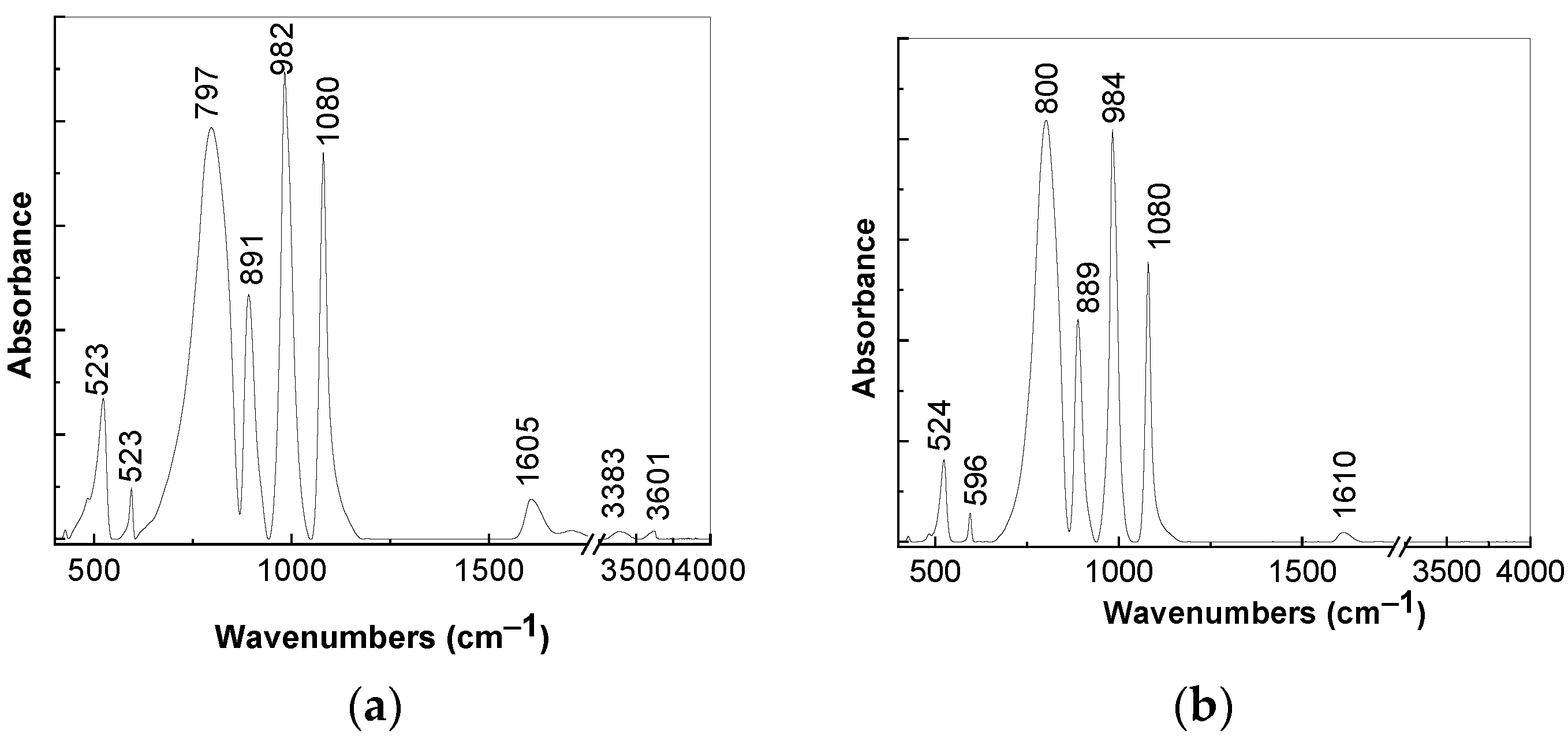

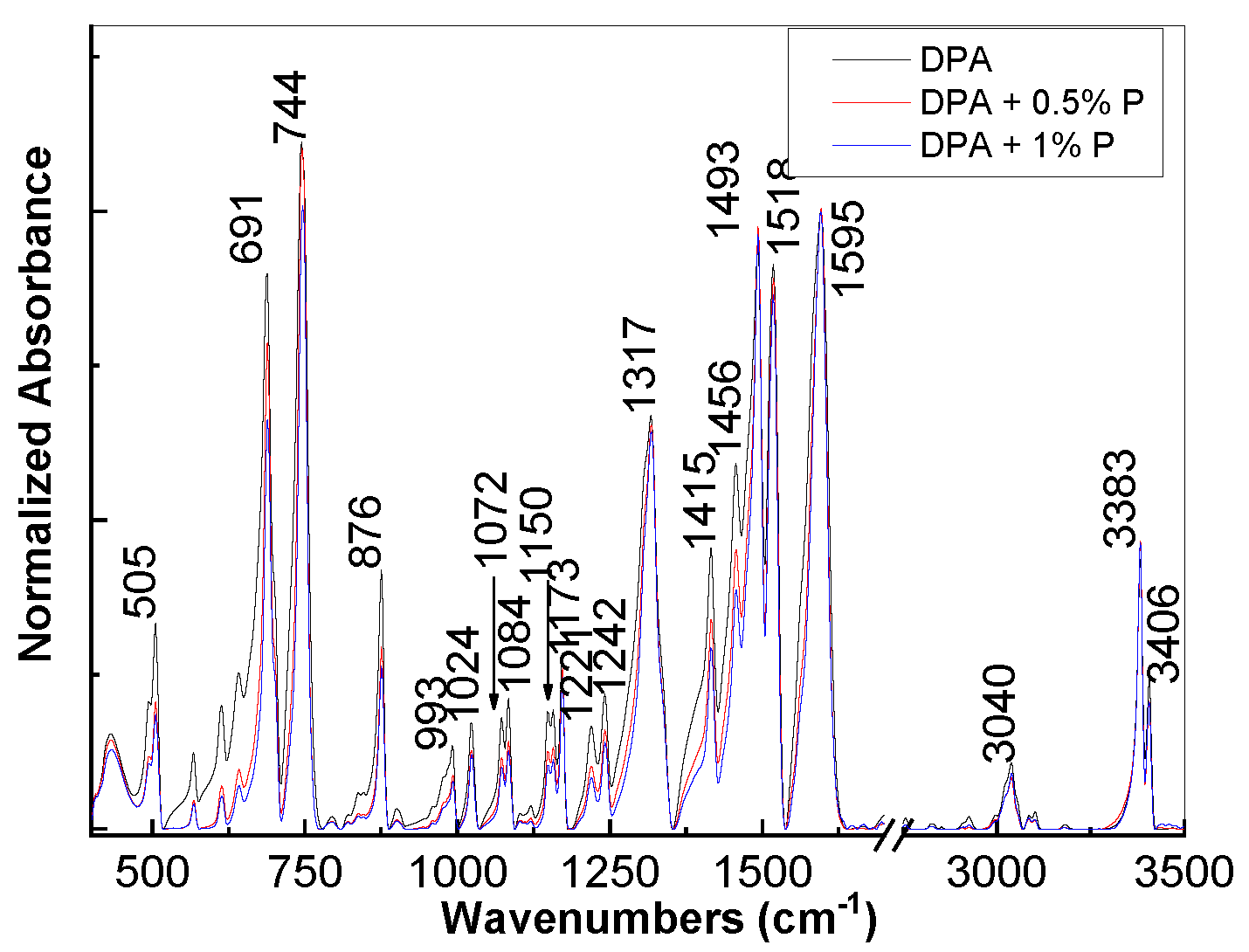

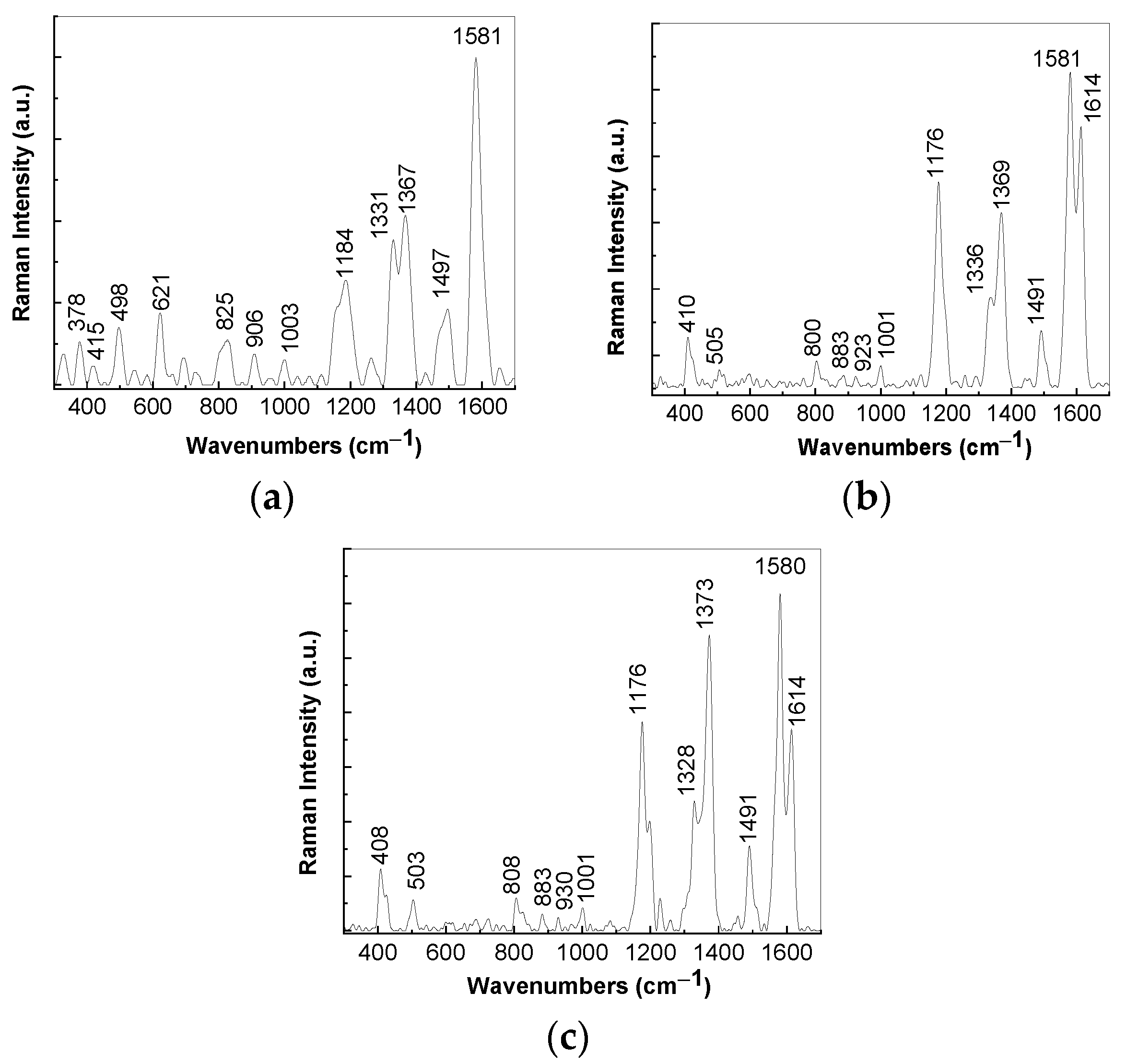
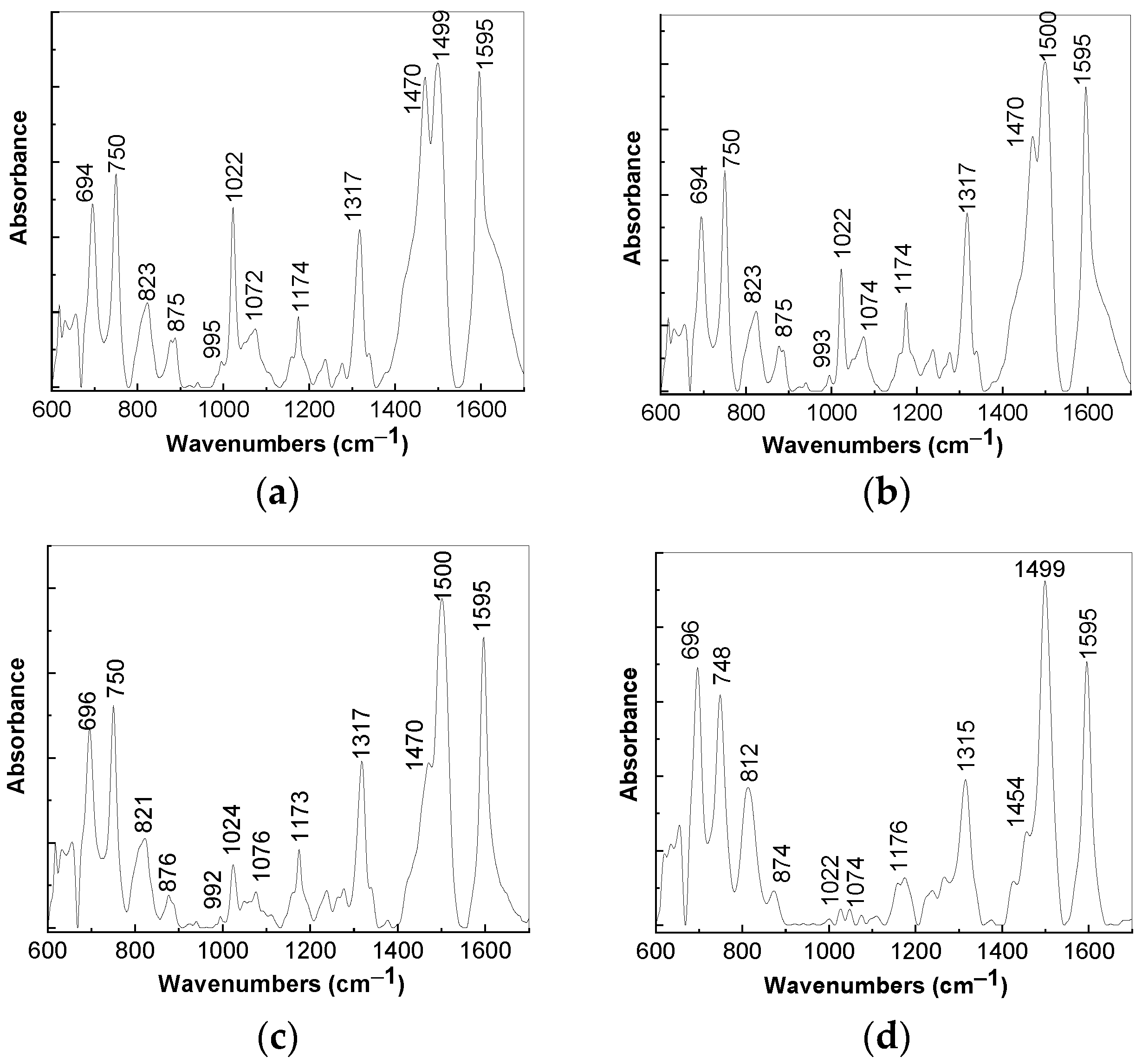

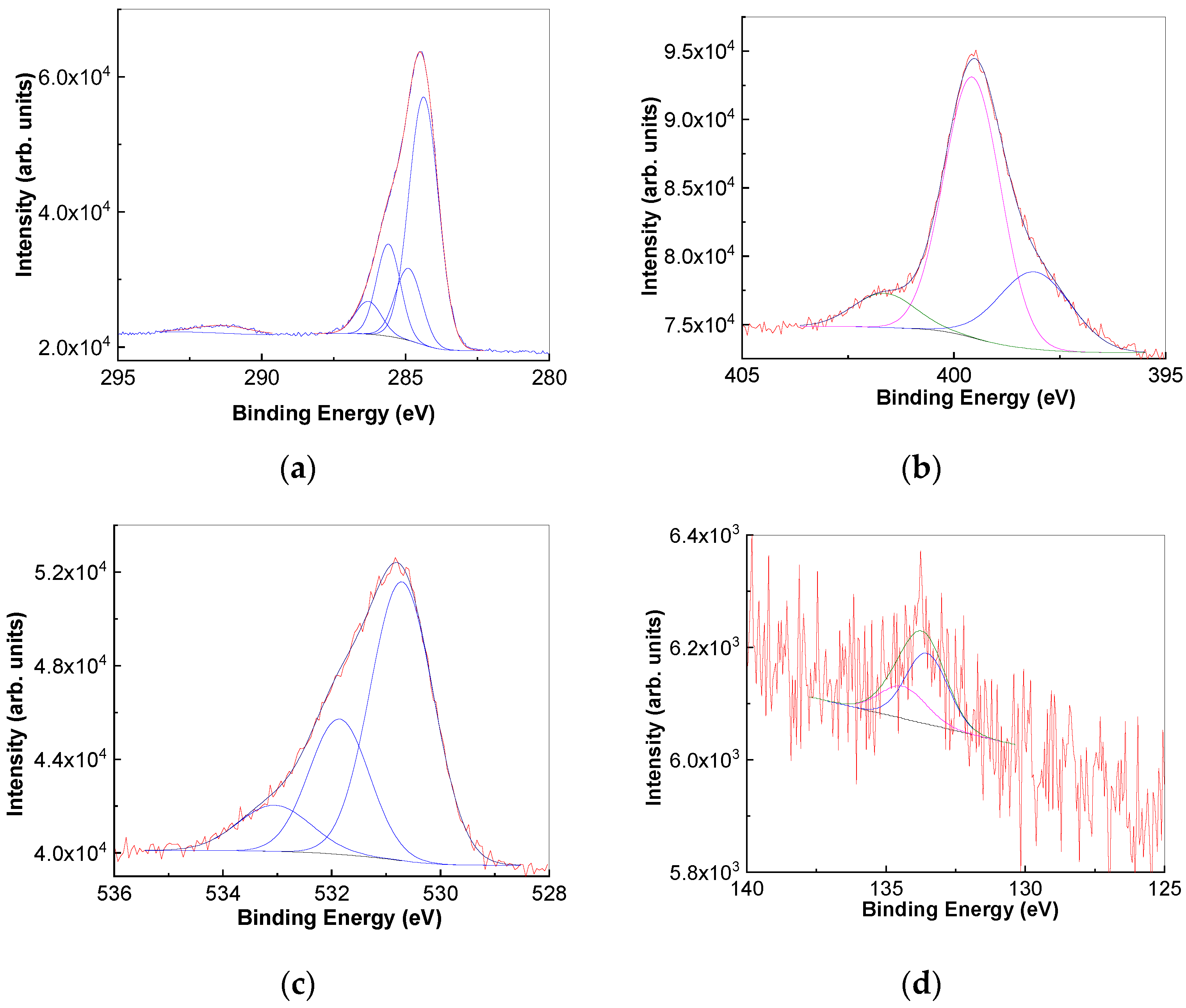
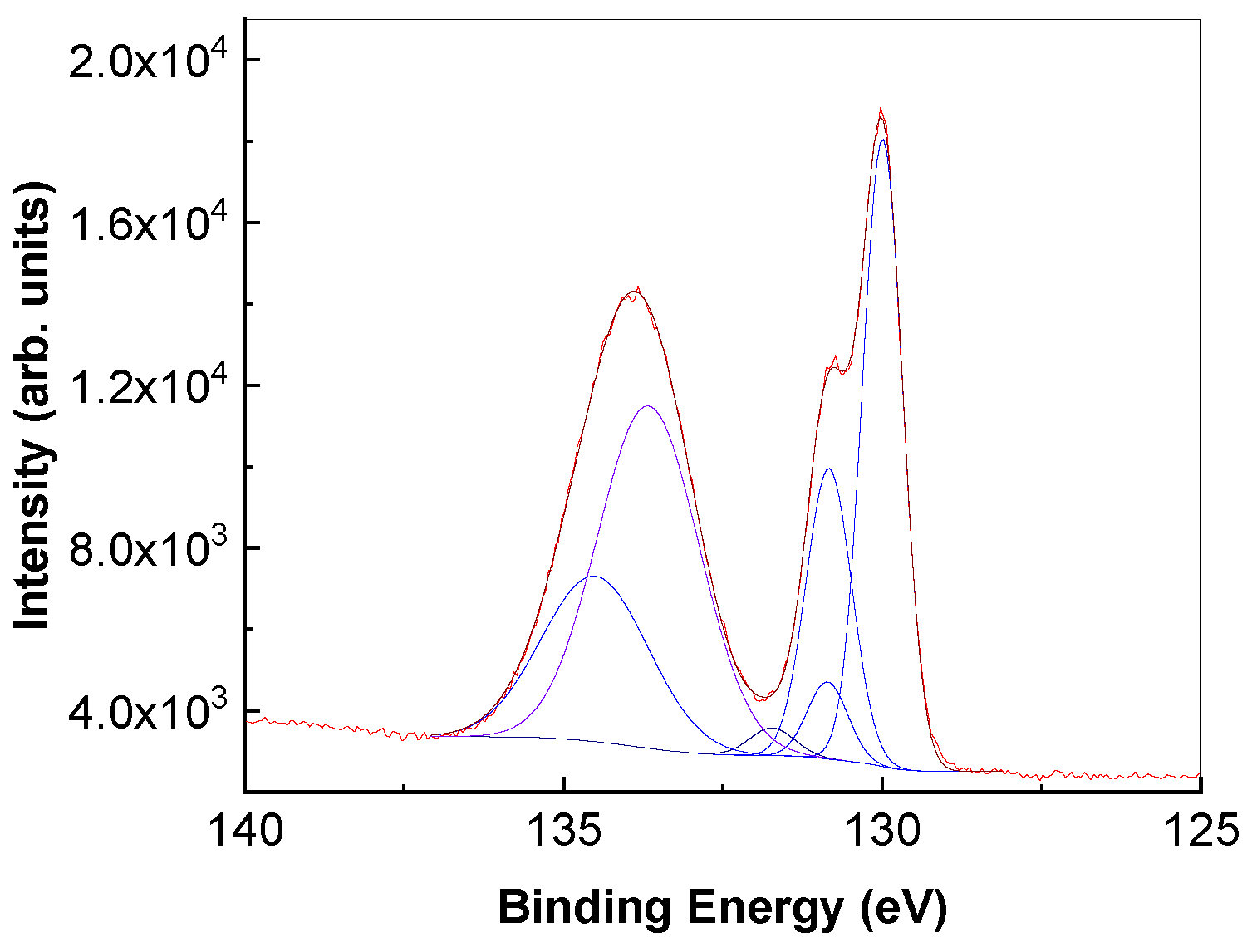
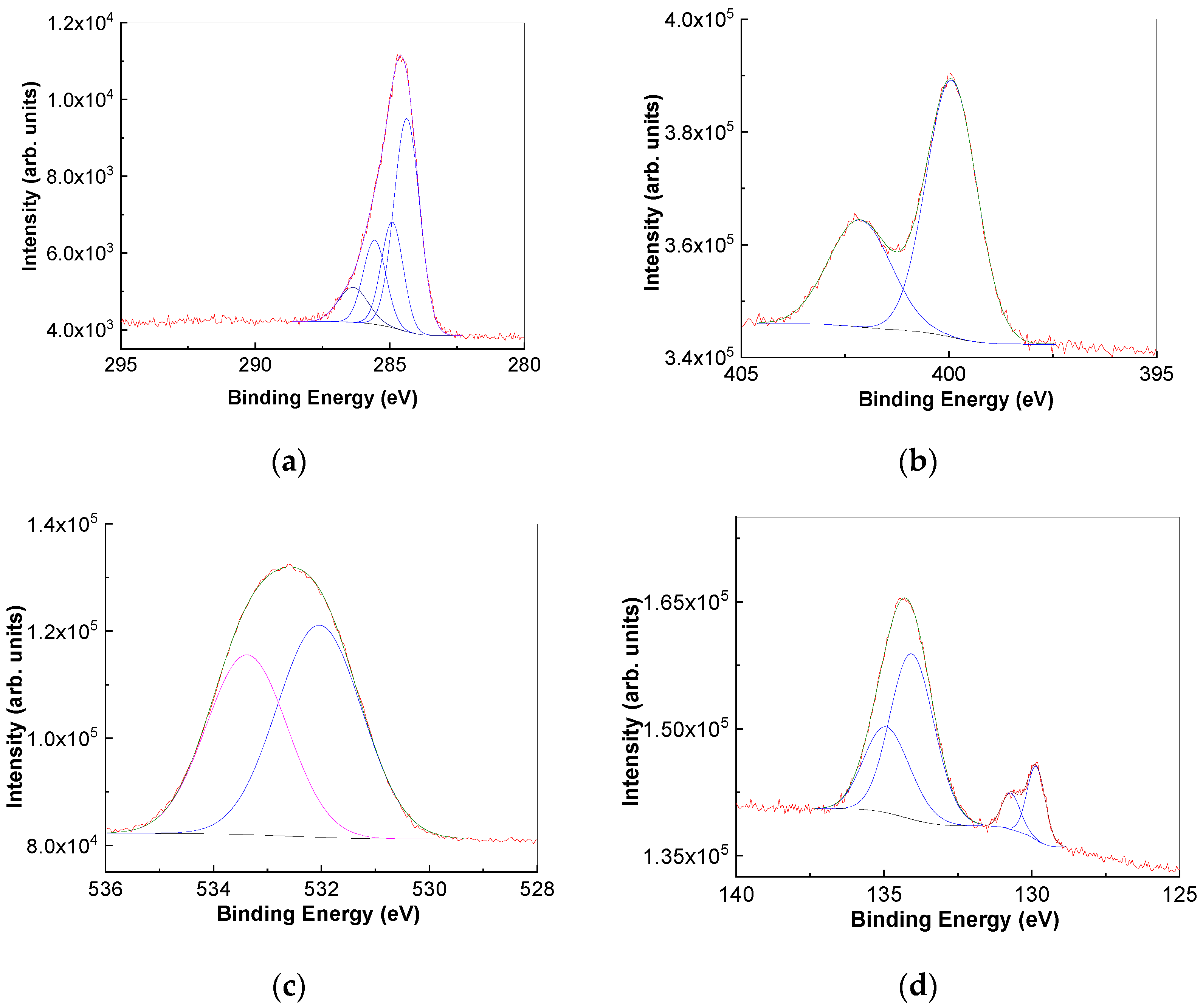

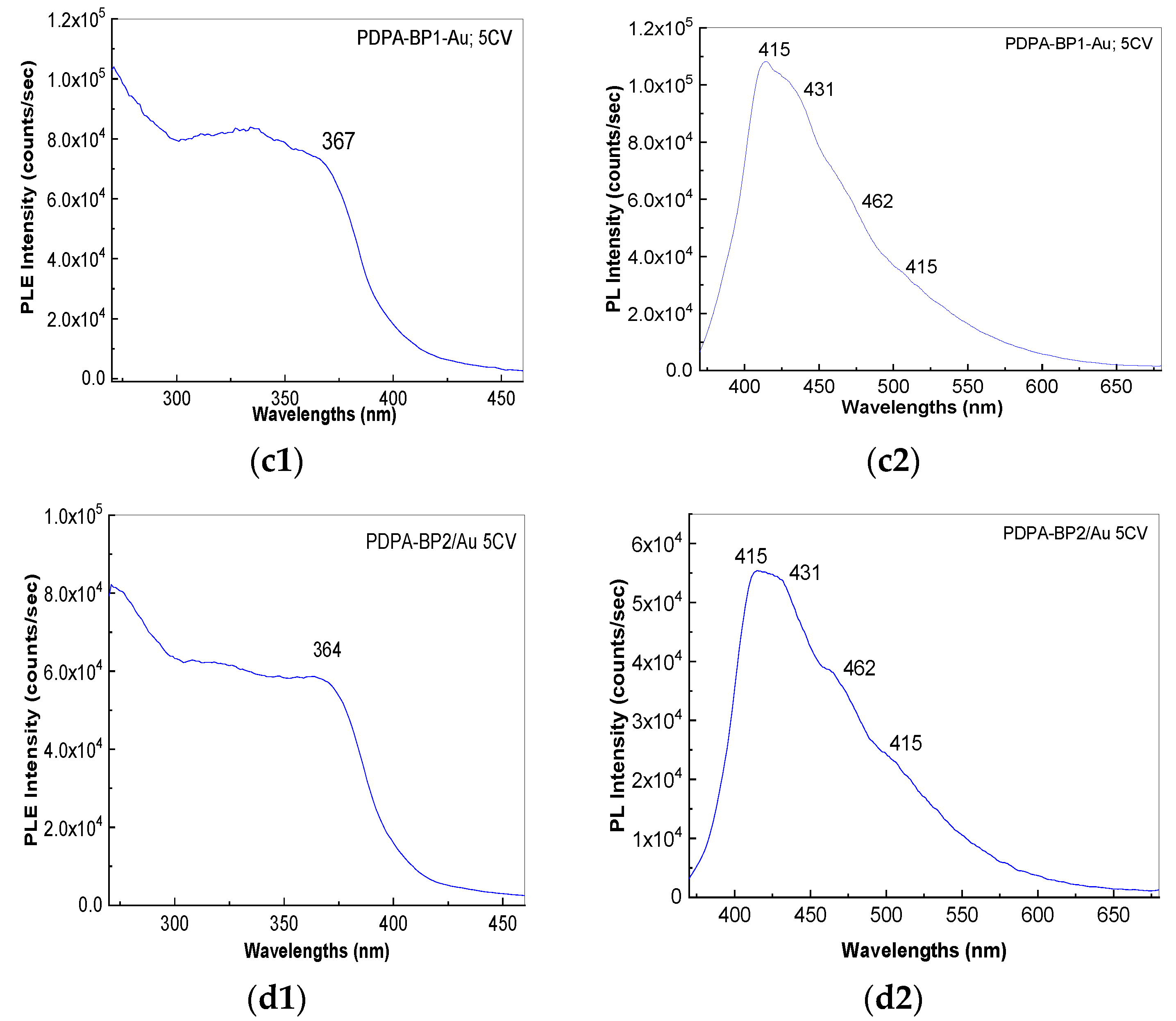

Publisher’s Note: MDPI stays neutral with regard to jurisdictional claims in published maps and institutional affiliations. |
© 2022 by the authors. Licensee MDPI, Basel, Switzerland. This article is an open access article distributed under the terms and conditions of the Creative Commons Attribution (CC BY) license (https://creativecommons.org/licenses/by/4.0/).
Share and Cite
Baibarac, M.; Burlanescu, T.; Stroe, M.; Smaranda, I.; Negrila, C. The Photoluminescence and Vibrational Properties of Black Phosphorous Sheets Chemically/Electrochemically Functionalized in the Presence of Diphenylamine. Polymers 2022, 14, 4479. https://doi.org/10.3390/polym14214479
Baibarac M, Burlanescu T, Stroe M, Smaranda I, Negrila C. The Photoluminescence and Vibrational Properties of Black Phosphorous Sheets Chemically/Electrochemically Functionalized in the Presence of Diphenylamine. Polymers. 2022; 14(21):4479. https://doi.org/10.3390/polym14214479
Chicago/Turabian StyleBaibarac, Mihaela, Teodora Burlanescu, Malvina Stroe, Ion Smaranda, and Catalin Negrila. 2022. "The Photoluminescence and Vibrational Properties of Black Phosphorous Sheets Chemically/Electrochemically Functionalized in the Presence of Diphenylamine" Polymers 14, no. 21: 4479. https://doi.org/10.3390/polym14214479





